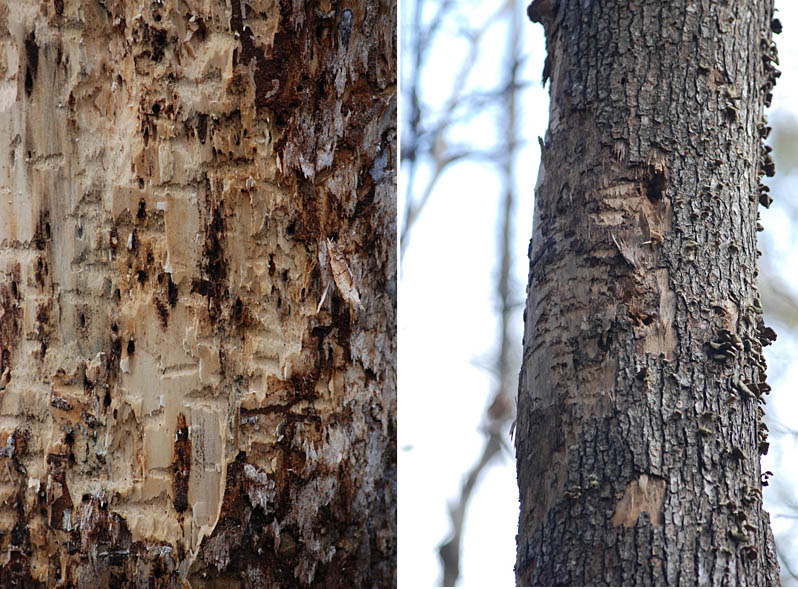For the uninitiated, let me explain that we were searching for the Ivory-Billed Woodpecker, the avian equivalent of Big Foot. Declared extinct in the 1940's by the then pre-eminent expert on the bird, it was given up as lost despite persistent rumors among birders that it was still being sighted. In 2004 a grainy, "big-foot"- quality video was made of a bird in an Arkansas swamp causing much excitement, but was dismissed by critics as an aberrant Pileated woodpecker. Since then the attention of researchers was diverted to the Florida panhandle, which is where we went last week.
I had the good fortune to be invited to be a part of an adjunct study to the Auburn U. Ivory-Bill research group in the Choctohatchee River basin north of Destin, Florida. It is a 64 square mile study area. We arrived in the study area Jan 11, '08, and hiked to a known "hot spot" where we found trees that the Ivory Billed Woodpeckers had been feeding on. They leave a unique horizontal groove in the wood when they chisel the bark off of dead trees in search of grubs. The next day we got out very early in the morning and stationed 5 people in various spots within a hundred yards of the feeding tree. I was in a kayak, parked in a cypress/gum swamp across the creek from the tree. I heard some Pileated woodpeckers raising a ruckus about 100 yards from me, and from that direction came a large, dark woodpecker. Thinking it must be a Pileated, I wasn't in a big hurry to raise the camera up (A Nikon D80 with a 300mm lens was around my neck). The bird landed on a cypress tree about 20 yards from me, but on the other side. Thinking that I might as well practice on this "Pileated" I was raising the camera up to focus on the tree when it took off and flew right over my head at about 15 feet up. It was then that my eyes fixed on the brilliant white secondaries, the trailing edge of the wing. In the 3-4 seconds that the bird was in view, I could clearly see the field marks of the Ivory-Bill, but still didn't believe what I was seeing. It passed over my head and off to the east. By the time I turned the kayak around, it was long gone. I paddled down to team member Sally Wolliver about a hundred yards away, and she was gesturing wildly that she had seen an Ivory Bill. We quickly determined it had to be the same bird I saw because of the direction and timing. I checked the Sibley guide with her, which has an illustration of the underside of the Pileated's wings, and then I was absolutely sure that what I had seen was NOT a Pileated! Other factors that confirmed the sighting were behavioral, the flat flight profile (not undulating like a Pileated), and no vocalization as the Pileated is prone to do. We heard the distinctive double-knock drumming sounds in the area as well. The Auburn group has had several sightings in this area, too.
Let me say that I went on this expedition as a big skeptic. I know people far more skilled than I at birding who have spent months and months in the field looking for this bird without success. I read the skeptics' websites and found them convincing, so I thought this would just be a great excuse to go kayaking in a pristine river swamp and take pictures. Count me among the hard-core believers now. I also feel a bit guilty about it, as if I were an unworthy heathen just given a vision of the Lord God (Bird). I was in the field less than 24 hours and the thing practically lands on my head.
So why didn't I get off a shot? For the same reasons that no one else has managed to do it. The glimpses are fleeting--a few seconds of fly-by in a dense swamp forest, and hesitation because of skepticism and thinking that it was a Pileated Woodpecker at first glance. I am now consumed by "If only..." --If only I had been quick to prepare, I would have been focused and ready when the bird took off toward me. A photo would have gone a long way to convince skeptics, and possibly save this area from being turned from pristine river swamp into a major international airport (the state gov has picked this wilderness as their favored site).
Now the Auburn group has set up time-lapse and video cameras in this spot in hopes that the bird has a roost in the area.
Let's wish them luck! !
email me at johnagnew@fuse.net if you would like to discuss my sighting. I will not give out any specific locations in order to protect Auburn's research area. Crowds of birders showing up could actually chase the IBW's off! They have been known to abandon nest sites because of too much human traffic.
Watch for my painting of the Ivory Billed Woodpecker. I've been told that I am the first wildlife artist to see a live Ivory Bill since Don Eckleberry in the 1930's!
Here is a link to Auburn University's Ivory-Bill site:
http://www.auburn.edu/academic/science_math/cosam/departments/biology/faculty/webpages/hill/ivorybill/index.html

A sketch made shortly after my sighting

A tree where Ivory Bills have been foraging
.

A large spring, with cypress typical of the study area
.

Bob Anderson in camo suit kayaking in study area

Morning mist near the spot where I spotted the Ivory Billed Woodpecker